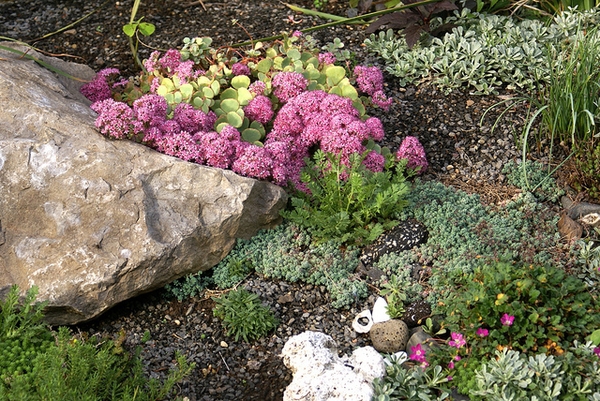Hylotelephium sieboldii
Common Name(s):
Previously known as:
- Sedum sieboldii
- Phonetic Spelling
- hy-loh-teh-LEF-ee-um see-BOLD-ee-eye
- This plant has low severity poison characteristics.
- See below
- Description
-
Japanese stonecrop is a succulent, perennial groundcover that is native to Japan, where it can be found growing along rocky outcrops and cliffs. It is a member of the stonecrop family (Crassulaceae). The scientific name honors the German botanist Phillipp Franz von Siebold.
It grows best in full sun to partial shade and in loam or sandy soil with very good drainage and a neutral or alkaline pH. Too much shade will result in weak, floppy plant growth. It has good drought tolerance, making it suitable for xeriscaping. When grown in a container, allow the soil to dry out before watering. Repot in spring. Propagate Japanese stonecrop by division, seed, or stem cutting. It grows 6 to 9 inches tall and 1 to 1.5 feet wide.
A plant for all seasons, springtime brings blue-green foliage. The foliage will display pink edges through the hot summer months. As fall approaches and the flowers are in full bloom, the foliage will turn bright shades of orange and red, making a stunning sight.
Use Japanese stonecrop in mass plantings, small groups, or borders in butterfly, children’s, drought-tolerant, or pollinator gardens. It attracts pollinators and songbirds. Also consider it for a recreational play area, on a slope or bank, or alongside a walkway or patio.
Insects, diseases, and other plant problems: Slugs, snails, aphids, mealybugs, and some scale insects can visit this plant. Overwatering or wet sites can lead to root and crown rot.
VIDEO Created by Elisabeth Meyer for "Annuals, Perennials, Vines, and Groundcovers" a plant identification course offered in partnership with Longwood Gardens.
- Profile Video:
- See this plant in the following landscape:
- Cultivars / Varieties:
-
- 'Nana'
- 'Nana'
- 'Nana'
- Tags:












- Cultivars / Varieties:
-
- 'Nana'
- 'Nana'
- 'Nana'
- Tags:
-
-
Attributes:
- Genus:
- Hylotelephium
- Species:
- sieboldii
- Family:
- Crassulaceae
- Uses (Ethnobotany):
- When planted in masses, makes a great ground cover in temperate locations.
- Life Cycle:
- Perennial
- Recommended Propagation Strategy:
- Division
- Seed
- Stem Cutting
- Country Or Region Of Origin:
- Japan
- Wildlife Value:
- Butterflies, flies, and bees are attracted to the flowers.
- Play Value:
- Attractive Flowers
- Attracts Pollinators
- Textural
- Edibility:
- If causes low toxicity if eaten. However, when very young and tender, the stems and leaves can be eaten raw. Later, until they flower, they may be briefly cooked.
- Dimensions:
- Height: 0 ft. 6 in. - 0 ft. 9 in.
- Width: 1 ft. 0 in. - 1 ft. 6 in.
-
-
Whole Plant Traits:
- Plant Type:
- Edible
- Ground Cover
- Perennial
- Habit/Form:
- Arching
- Horizontal
- Mounding
- Growth Rate:
- Medium
- Maintenance:
- Low
- Texture:
- Fine
-
-
Cultural Conditions:
- Light:
- Full sun (6 or more hours of direct sunlight a day)
- Partial Shade (Direct sunlight only part of the day, 2-6 hours)
- Soil Texture:
- Loam (Silt)
- Sand
- Soil pH:
- Alkaline (>8.0)
- Neutral (6.0-8.0)
- Soil Drainage:
- Good Drainage
- Occasionally Dry
- Very Dry
- Available Space To Plant:
- Less than 12 inches
- 12 inches-3 feet
- NC Region:
- Coastal
- Mountains
- Piedmont
- USDA Plant Hardiness Zone:
- 3a, 3b, 4a, 4b, 5a, 5b, 6a, 6b, 7a, 7b, 8a, 8b, 9a, 9b
-
-
Fruit:
- Fruit Type:
- Capsule
- Fruit Description:
- Small capsules open to release tiny dark seeds.
-
-
Flowers:
- Flower Color:
- Pink
- Flower Value To Gardener:
- Showy
- Flower Bloom Time:
- Fall
- Flower Shape:
- Star
- Flower Size:
- < 1 inch
- Flower Description:
- In the fall, clusters of pink flowers form at the end of the stems.
-
-
Leaves:
- Leaf Color:
- Green
- Pink
- Leaf Feel:
- Fleshy
- Leaf Value To Gardener:
- Edible
- Showy
- Deciduous Leaf Fall Color:
- Pink
- Leaf Type:
- Simple
- Leaf Arrangement:
- Whorled
- Leaf Margin:
- Entire
- Hairs Present:
- No
- Leaf Length:
- < 1 inch
- Leaf Width:
- < 1 inch
- Leaf Description:
- This plant forms a perfect, circular mound of arching stems covered with fleshy, round, blue-green foliage in whorls of three. They are edged with a deep pink to reddish line. Turns pink in winter before dying.
-
-
Stem:
- Stem Color:
- Green
- Red/Burgundy
- Stem Is Aromatic:
- No
- Stem Description:
- The ascending stem have a reddish tinge.
-
-
Landscape:
- Landscape Location:
- Container
- Patio
- Recreational Play Area
- Slope/Bank
- Walkways
- Landscape Theme:
- Asian Garden
- Butterfly Garden
- Children's Garden
- Cottage Garden
- Drought Tolerant Garden
- Pollinator Garden
- Rock Garden
- Design Feature:
- Border
- Mass Planting
- Small groups
- Attracts:
- Bees
- Butterflies
- Pollinators
- Songbirds
- Resistance To Challenges:
- Drought
- Dry Soil
- Poor Soil
- Rabbits
- Problems:
- Poisonous to Humans






